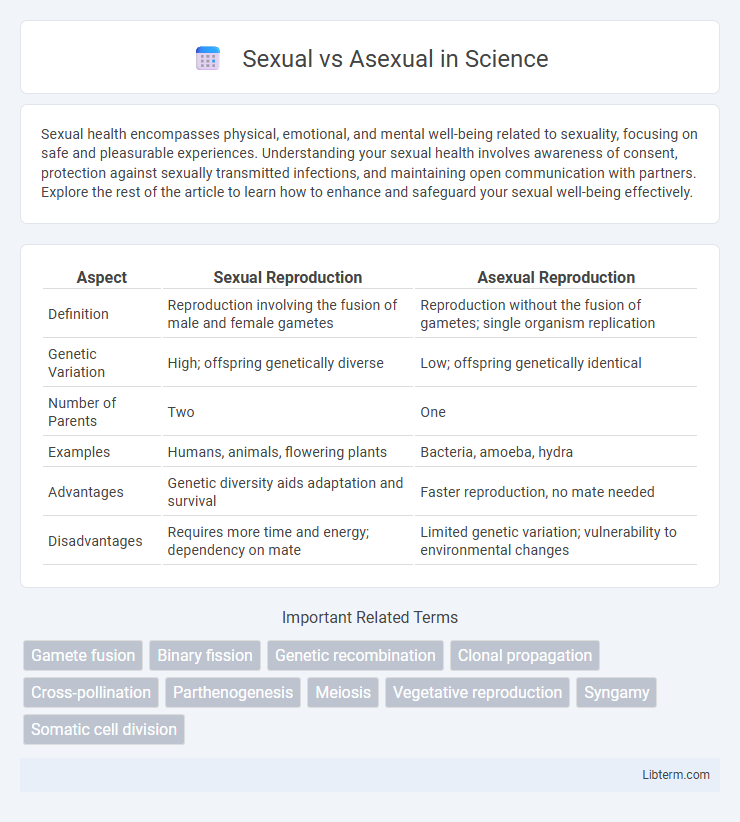Sexual health encompasses physical, emotional, and mental well-being related to sexuality, focusing on safe and pleasurable experiences. Understanding your sexual health involves awareness of consent, protection against sexually transmitted infections, and maintaining open communication with partners. Explore the rest of the article to learn how to enhance and safeguard your sexual well-being effectively.
Table of Comparison
| Aspect | Sexual Reproduction | Asexual Reproduction |
|---|---|---|
| Definition | Reproduction involving the fusion of male and female gametes | Reproduction without the fusion of gametes; single organism replication |
| Genetic Variation | High; offspring genetically diverse | Low; offspring genetically identical |
| Number of Parents | Two | One |
| Examples | Humans, animals, flowering plants | Bacteria, amoeba, hydra |
| Advantages | Genetic diversity aids adaptation and survival | Faster reproduction, no mate needed |
| Disadvantages | Requires more time and energy; dependency on mate | Limited genetic variation; vulnerability to environmental changes |
Understanding Sexual and Asexual Reproduction
Sexual reproduction involves the combination of genetic material from two parent organisms, resulting in genetically diverse offspring and increased adaptability in changing environments. Asexual reproduction occurs without the fusion of gametes, producing genetically identical offspring which allows for rapid population growth in stable conditions. Understanding the mechanisms and advantages of both reproductive strategies is essential for studying biological diversity and evolutionary processes.
Key Differences Between Sexual and Asexual Reproduction
Sexual reproduction involves the combination of genetic material from two parent organisms, resulting in genetically diverse offspring, while asexual reproduction produces genetically identical offspring from a single parent. Key differences include the involvement of gametes in sexual reproduction versus no gametes in asexual reproduction, and the increased genetic variation in sexual reproduction compared to the uniformity seen in asexual reproduction. Sexual reproduction typically requires more time and energy, whereas asexual reproduction allows rapid population growth under stable conditions.
Advantages of Sexual Reproduction
Sexual reproduction enhances genetic diversity by combining different alleles from two parents, which increases a population's ability to adapt to changing environments and resist diseases. The resulting genetic variation accelerates evolution and enables natural selection to act more effectively on beneficial traits. This adaptability provides a significant survival advantage over asexual reproduction, which produces genetically identical offspring.
Benefits of Asexual Reproduction
Asexual reproduction allows organisms to reproduce rapidly and efficiently without the need for a mate, ensuring quick population growth and stability in stable environments. This mode of reproduction conserves energy and resources since it bypasses the complex processes of mating and fertilization. Additionally, offspring from asexual reproduction are genetically identical to the parent, preserving successful gene combinations and maintaining advantageous traits within a population.
Genetic Variation in Sexual vs Asexual Reproduction
Sexual reproduction generates genetic variation through the combination of alleles from two parents, resulting in offspring with unique genetic profiles. In contrast, asexual reproduction produces genetically identical clones since offspring inherit DNA exclusively from a single parent without genetic recombination. This genetic variation in sexual reproduction enhances adaptability and evolution, while asexual reproduction allows rapid population growth but limits evolutionary potential.
Examples of Organisms Using Sexual and Asexual Methods
Examples of organisms using sexual reproduction include mammals like humans and lions, as well as birds such as eagles and penguins, all of which rely on genetic material from two parents. Asexual reproduction is common in bacteria like Escherichia coli and protists such as amoebas, which reproduce through binary fission or budding without the need for genetic exchange. Plants such as strawberries and fungi like yeast also utilize asexual methods like runners and spore production to rapidly propagate.
Environmental Factors Influencing Reproduction Types
Environmental factors significantly influence the prevalence of sexual and asexual reproduction, with sexual reproduction favored in dynamic, unpredictable environments that promote genetic diversity for adaptation. Stable, consistent environments often lead to asexual reproduction dominance due to its efficiency and rapid population growth. Temperature, resource availability, and population density are critical parameters shaping the reproductive strategy in various species.
Evolutionary Implications: Sexual vs Asexual
Sexual reproduction fosters genetic diversity through the combination of alleles, enhancing a population's adaptability to changing environments and resistance to pathogens. In contrast, asexual reproduction produces genetically identical offspring, allowing rapid population growth but reducing variability, which may limit long-term evolutionary potential. The evolutionary implications highlight sexual reproduction's advantage in promoting variation and natural selection, while asexual reproduction favors stability and efficiency under stable conditions.
Energy and Resource Investment in Reproduction
Sexual reproduction requires significant energy and resource investment due to the production of gametes, mating behaviors, and often parental care to ensure offspring survival. Asexual reproduction demands fewer resources as it involves a single organism producing genetically identical offspring without the need for a mate or extensive parental investment. The trade-off between energy expenditure and genetic diversity influences the reproductive strategy chosen by different species.
Applications and Importance in Biotechnology and Agriculture
Sexual reproduction enables genetic diversity, crucial for developing disease-resistant crop varieties and improving livestock traits through selective breeding in agriculture and biotechnology. Asexual reproduction techniques like cloning and tissue culture facilitate rapid propagation of plants with desirable traits, ensuring uniformity and high yield in commercial production. These reproductive strategies underpin advances in genetic engineering, crop improvement, and sustainable agricultural practices by balancing variability and consistency.
Sexual Infographic

 libterm.com
libterm.com